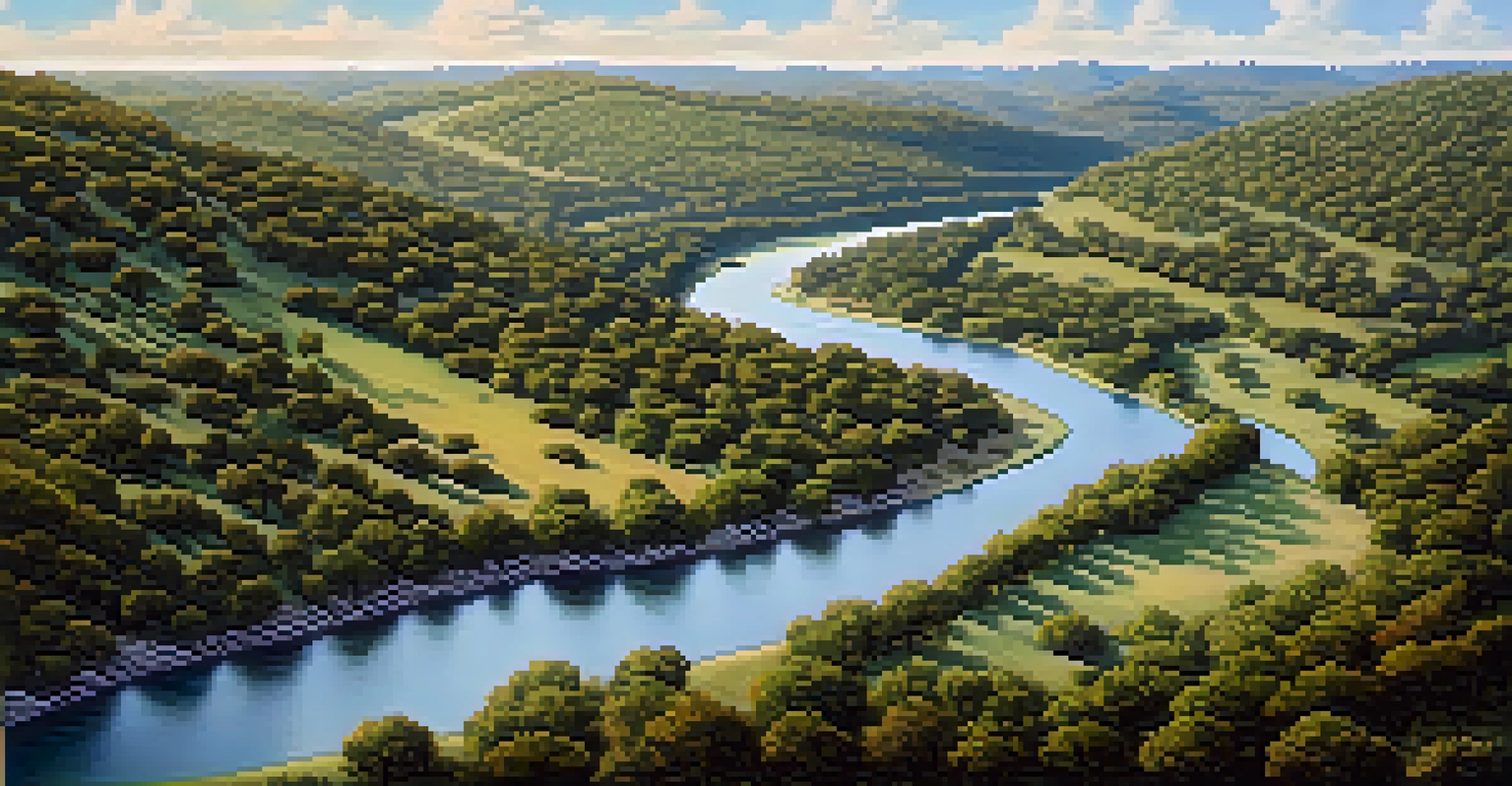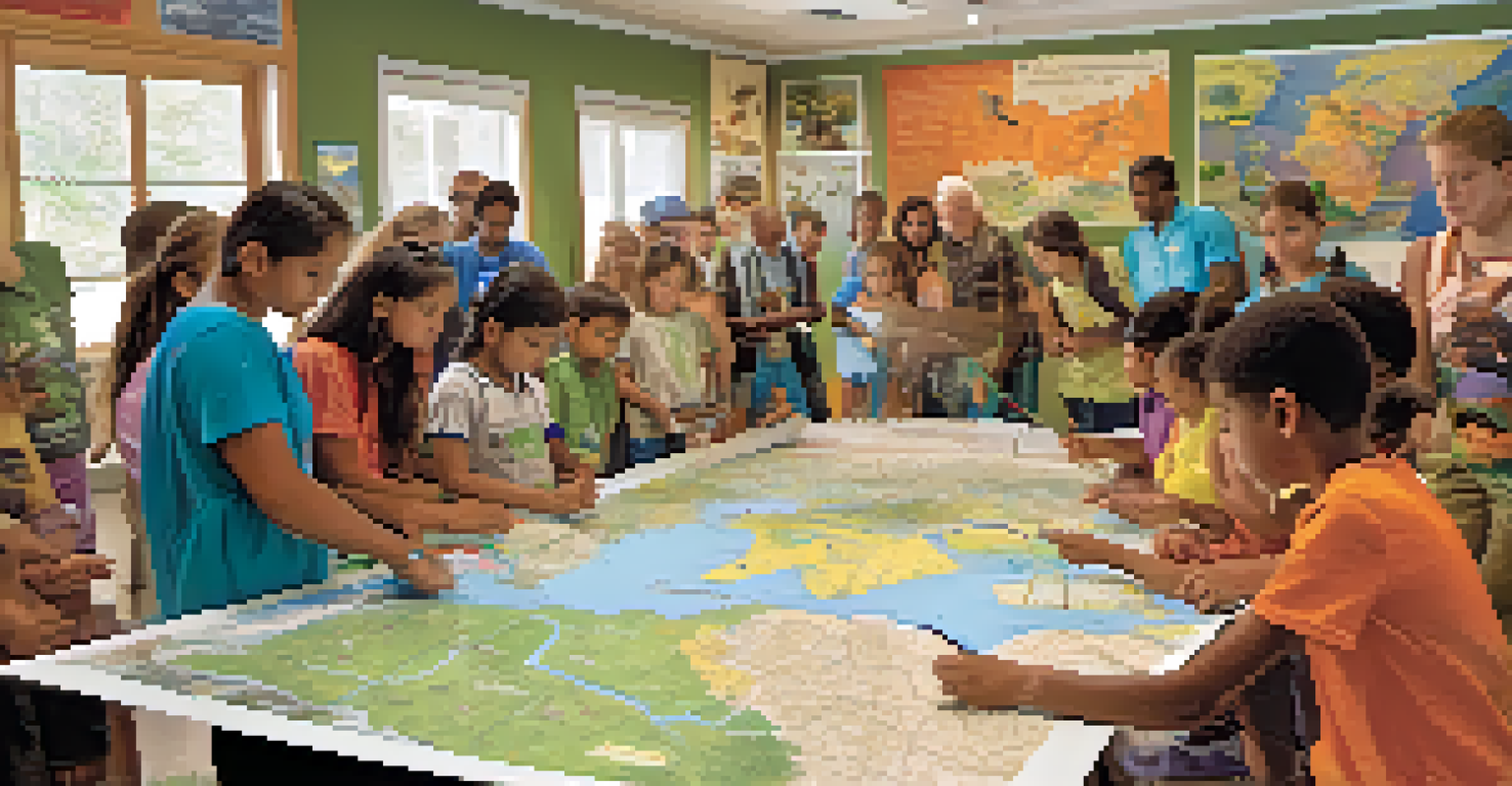Texas Wildlife Corridors: Connecting Habitats for Survival

Understanding Wildlife Corridors and Their Importance
Wildlife corridors are essential pathways that connect fragmented habitats, allowing animals to move freely between them. Imagine these corridors as nature's highways, enabling creatures to access food, mates, and shelter without the dangers of roads or urban areas. In Texas, where urban sprawl continues to expand, these corridors play a vital role in maintaining biodiversity and ecosystem health.
Conservation is a state of harmony between men and land.
The significance of wildlife corridors goes beyond just supporting animal movement; they also help sustain genetic diversity. When animal populations are isolated, inbreeding can occur, leading to weakened species. By connecting habitats, corridors allow different populations to mingle, promoting healthier, more resilient wildlife communities.
Furthermore, wildlife corridors contribute to the larger ecological balance. They help regulate ecosystems by allowing species to adapt to changing environments, such as climate change. Thus, investing in these corridors is not just beneficial for the animals; it is crucial for the health of our planet.
The Unique Ecosystems of Texas and Their Challenges
Texas is home to a diverse range of ecosystems, from coastal marshes to arid deserts and lush forests. Each of these environments hosts unique wildlife, making the state a biodiversity hotspot. However, rapid urbanization, agriculture, and infrastructure development threaten these ecosystems, leading to habitat loss and fragmentation.

As Texas continues to grow, animal populations are increasingly cut off from their natural habitats. This creates 'habitat islands' where species struggle to survive. For example, the iconic Texas horned lizard is facing declining numbers due to habitat encroachment, making wildlife corridors even more critical for their survival.
Wildlife Corridors Connect Habitats
Wildlife corridors serve as essential pathways that link fragmented habitats, allowing animals to move freely and maintain biodiversity.
Moreover, the challenges faced by wildlife in Texas aren't just about space; they also involve climate change and human activity. As temperatures rise and weather patterns shift, many species find it difficult to adapt. Corridors can help mitigate these effects by providing safe routes to more suitable habitats.
Successful Examples of Texas Wildlife Corridors
Several projects in Texas have successfully established wildlife corridors, showcasing the potential of these critical pathways. One notable example is the South Texas Nighthawk Corridor, which connects areas crucial for the conservation of the endangered black-capped vireo. This initiative has not only helped protect the species but also raised awareness about the importance of preserving natural habitats.
The greatness of a nation and its moral progress can be judged by the way its animals are treated.
Another success story is the development of the Hill Country Wildlife Corridor, which aims to connect the fragmented landscapes of the Texas Hill Country. This corridor provides a safe passage for various species, including the elusive bobcat and the endangered golden-cheeked warbler. Such projects demonstrate how targeted efforts can lead to meaningful conservation outcomes.
These examples highlight the collaborative approach needed to make wildlife corridors successful. Partnerships between local governments, conservation organizations, and communities have been key to these initiatives, proving that when we work together, we can create lasting change for wildlife.
The Role of Community in Wildlife Corridor Initiatives
Community involvement is crucial for the success of wildlife corridor initiatives. Local residents are often the first line of defense against habitat loss, and their support can make a significant difference. Engaging communities in conservation efforts fosters a sense of ownership and responsibility toward local wildlife and habitats.
Educational programs and outreach initiatives can empower community members to take action. For instance, workshops on the importance of wildlife corridors can inspire citizens to advocate for these projects or even create wildlife-friendly spaces in their own backyards. This grassroots involvement can amplify conservation efforts significantly.
Community Involvement is Key
Engaging local communities in wildlife corridor initiatives fosters a sense of ownership and enhances conservation efforts.
Moreover, when communities are involved in the planning and implementation of wildlife corridors, the solutions are often more effective. Local knowledge and insights can lead to tailored approaches that consider the unique challenges each area faces, ultimately resulting in better outcomes for wildlife.
Legislation and Policy Supporting Wildlife Corridors
Legislation plays a vital role in the establishment and maintenance of wildlife corridors. In Texas, several laws and policies support conservation efforts, which can directly benefit wildlife corridors. For example, the state's commitment to the Texas Conservation Plan includes measures to protect critical habitats and support wildlife movement.
Additionally, initiatives like the Land and Water Conservation Fund provide resources for creating and maintaining wildlife corridors. These funds can be used for land acquisition, habitat restoration, and community education, ensuring that corridors remain effective for wildlife. Policymakers must recognize the importance of these corridors and prioritize them in conservation strategies.
Furthermore, collaboration between state agencies and conservation organizations is essential for effective policy implementation. By working together, these entities can create comprehensive plans that address habitat fragmentation and promote connectivity, ultimately benefiting both wildlife and communities.
Challenges Ahead: Overcoming Obstacles to Corridor Success
Despite the successes of wildlife corridors in Texas, several challenges remain. One significant obstacle is funding; while there are programs in place, securing consistent financial support can be difficult. Conservation projects often rely on donations and grants, which can fluctuate and create uncertainty for long-term initiatives.
Another challenge is public perception and awareness. Many people may not understand the importance of wildlife corridors or how they operate. Education and outreach efforts are essential to inform the public about the benefits of these corridors, helping to garner support and participation in conservation initiatives.
Legislation Supports Conservation Efforts
Policies and funding are crucial for establishing and maintaining wildlife corridors, ensuring the protection of critical habitats.
Additionally, the ongoing threat of urban development poses a considerable risk to wildlife corridors. As cities expand, habitats may continue to be fragmented, hindering the effectiveness of existing corridors. Strategic planning and community involvement are crucial to mitigate these threats and ensure that wildlife corridors remain functional for generations to come.
The Future of Texas Wildlife Corridors: A Path Forward
The future of Texas wildlife corridors looks promising, thanks to ongoing efforts from conservationists, communities, and policymakers. Increased awareness of the importance of connecting habitats is leading to more collaborative initiatives. As more people recognize the value of wildlife corridors, support for these projects is likely to grow.
Innovative approaches, like using technology to monitor wildlife movement and identify critical areas for corridor development, are also on the rise. These advancements can help optimize corridor design and effectiveness, ensuring that they meet the needs of various species. The integration of science and community engagement is key to creating robust wildlife corridors.

By continuing to advocate for wildlife corridors, we can foster a more harmonious relationship between humans and nature. With collective efforts, Texas can maintain its rich biodiversity and ensure that future generations will enjoy the incredible wildlife that calls this state home.